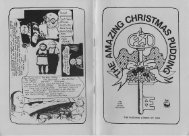Create successful ePaper yourself
Turn your PDF publications into a flip-book with our unique Google optimized e-Paper software.
EMI did not make their own glass master for the albums<br />
which they took over from SONY. Instead they used the<br />
glass master from USA and Europe (Uden, Holland). The<br />
only indication of Japanese editions is the Mould SID Code<br />
(inner ‘IFPI number’) which starts with 28.<br />
OBI<br />
The obi (already known from the Japanese vinyl issues) is<br />
a paper strip that wraps the jewel case from left to back.<br />
The information on an obi include the name of the artist,<br />
both the album and song's titles, price in Yen and some<br />
other information printed in Japanese.<br />
With exception of promotional issues, issues of Pulse and<br />
LP replica of Wish You Were Here all Japanese Pink Floyd<br />
CDs were issued with an obi. Some releases, for instance<br />
Pulse and the Shine On box have instead of an obi, a<br />
Japanese sticker on front. Sony’s cardboard sleeve<br />
replicas of the original LPs (with exception of Pulse) have<br />
both: obi and sticker.<br />
There are three types of CD obis:<br />
the regular one, that wrap the jewel case from left to<br />
back on about 2,5 cm each side<br />
the box-type one, like regular obi but wraps not only<br />
around the end of the case but also has a top and<br />
bottom<br />
the long-type one, that wrap the jewel case on about<br />
2,5 cm on the front and the whole rear side of the<br />
case<br />
Examples of an obi. Left a regular one (A Momentary Lapse of Reason),<br />
right a long type obi (David Gilmour’s On An Island)<br />
Maximum three dates are printed on the artwork (older<br />
issues) or on obi (newer issues) of the Japanese CDs.<br />
Most of them are printed as yy.mm.dd or yyyy.mm.dd.<br />
Two of the dates are printed in a rectangle. The first date<br />
in the rectangle is the release date of this particular issue.<br />
The date in parentheses is the date the album was<br />
originally released, in some cases (for example on mini LP<br />
releases) this is the date of the Vinyl LP release.<br />
To the right of these two dates one can see the capital Y<br />
inside a circle: . This symbol means Yogaku and<br />
emphasize that the rights for this release is held by a non-<br />
Japanese <strong>com</strong>pany. Yogaku generally means Western<br />
Music. In Japan, there is a large CD rental industry and a<br />
lot of people will rent CDs and albums rather than<br />
purchase them. Western Music (Yogaku) is not allowed to<br />
be rented to the Japanese public for one year after the<br />
release date.<br />
The third date (sometimes printed close to the price) is the<br />
open market date - the date until which a seller must sell<br />
the CD at the fixed price as listed on the obi. After this date<br />
the CD can be sold at any price, the licence can be renegotiated,<br />
and the CD reissued (maybe by a different<br />
record <strong>com</strong>pany).<br />
On some editions released in the 1980s and 1990s a letter<br />
represents a specific year. The following is a list of the<br />
release years and which letter they represent:<br />
1984 N<br />
1985 I<br />
1986 H<br />
1987 O<br />
1988 R<br />
1989 E<br />
1990 C<br />
1991 D<br />
And here some examples of Pink Floyd albums with a<br />
letter representing the year of release:<br />
Piper at the Gates of Dawn CP32-5269:<br />
Meddle CP32-5032:<br />
Wish You Were Here 28DP 5005:<br />
Animals CSCS 6042:<br />
The Final Cut 32DP 364:<br />
A Momentary Lapse of Reason 32DP 820:<br />
O-2-25<br />
I-9-21<br />
R-2-26<br />
C-9-1<br />
I-8-25<br />
O-10-10<br />
Two examples of a box obi (Roger Waters' The Pros & Cons of Hitch<br />
Hiking).<br />
Since 1986 the barcode is printed on obi. A Japanese CD<br />
is considered in<strong>com</strong>plete without the obi.<br />
Dates and Prices<br />
Typical of the Japanese CDs are dates and prices printed<br />
on the obis.<br />
All Japanese CDs have the price printed on the obi. Only<br />
one price is printed on older issues, whilst the recent<br />
issues have two prices printed. The higher price is<br />
including tax, whilst the lower price is excluding tax. Even<br />
though there is always a flat 5% tax it is a legal demand to<br />
display both prices.<br />
Mini LP<br />
On the Toshiba and Sony labels nearly all Pink Floyd<br />
albums and three Roger Waters’ albums were released as<br />
cardboard sleeve replica of the LP issues. These replicas<br />
are also known as 'mini LPs'. For many years the<br />
Japanese replicas were the only replicas on the market.<br />
But in 2007 EMI UK released mini copies of the LPs on<br />
CDs in Europe. See chapter 'Cardboard Sleeve LP<br />
Replica' for detailed description of these editions.<br />
Japanese Sample<br />
Nearly all official Japanese editions (regularly issued CDs<br />
and the mini LPs) exist as promotional 'samples'. The only<br />
difference between the regular edition and such sample is<br />
a small sticker attached on the back of the CD case and<br />
the writing "SAMPLE" close to the centre hole.<br />
The samples are not included in the discography.<br />
Semi Official Releases<br />
In Japan, it is possible to purchase the rights to print not<br />
only a full CD, but also selected songs, in order to create<br />
private <strong>com</strong>pilations. Those are the so-called semi-official.<br />
Japanese semi-official issues are not included in the<br />
discography.






